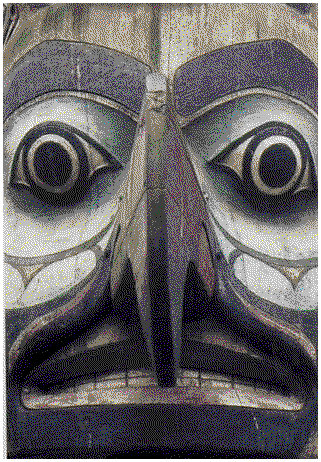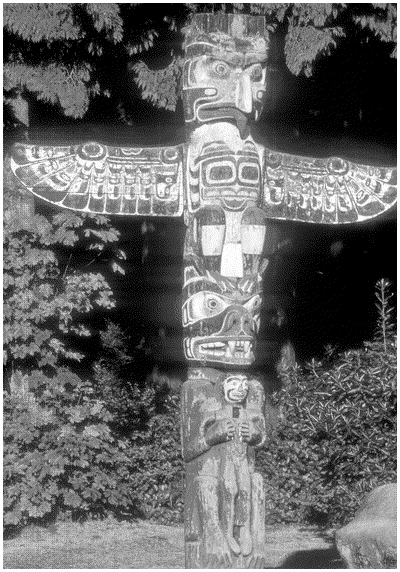A Traveler's Guide
Aldona Jonaitis
(University of Washington /
Douglas & McIntyre)

They are thus not ancient and sacramental. Because of their location --- mostly in coastal Washington state, British Columbia, and Alaska --- high humidity, wet --- and since most are carved from cedar, without preservatives, any truly old ones have rotted away long ago. Unless they were stolen from the families and stuck away in a museum.
And just to further confuse you, she tells us that the concept of "the low man on the totem pole" is meaningless. Even the word 'totem' is misused:
- The position of an image on a totem pole has no relevance to its importance. And totemism is, strictly speaking, an anthropological term for a particular type of belief in which a clan believes itself to be descended from a particular protective animal (the totem) ...
With these tart words, Dr. Jonaitis launches into an exploration of fifty totem poles that live in Seattle, along the coast of the Strait of Georgia, and all the way up Sitka. There are photographs (both historical and current), descriptions of the key elements of the poles and clan houses, some examples of recent carvings, descriptions of the people who specialize in contemporary carving, and thoughts about the current proliferation. She points out that there are more totem poles in existence now than ever before, and people's enthusiasm for them seems to know no bounds.
One of the most beguiling --- at least to this reader --- is one from 1986, set in Stanley Park, Vancouver, by Tony Hunt. Jonaitis wonders why this particular one is so popular, appearing "on postcards, in advertisements for all sorts of things, even on paper plate mats in diners." She suggests that the wings on the second figures must imply a religious bias: "it is possible the outstretched wings mounted on an upright post suggest the Christian cross."
I doubt it. The wings are spectacular, but the yellow-beaked figure at the top (with those drop-dead eyes), the malevolent tooth-bared, huge red nose-y figure below, the hunched bear-like figure below that (eyes, again, crazed and malevolent) --- all these are the stuff of our worst nightmares. No wonder everyone loves it (me too), even though some of these figures look like they just got liberated from a Looney Tunes cartoon, the wonder is that Jonaitis scarcely mentions the Nut Factor in these creations, malicious figures with malicious frowns, huge pop-out eyes, gigantic purple beaks, squatty little figures hunched up below ready to spring at you and bite your head off. And the totem houses. Great wide sheds, one whole wall filled with a toothy, smiling face (you enter through the mouth.) A more friendly building has, I claim, never been invented.

A real and final problem with Discovering Totem Poles is the scale. If you are going to do a book about huge carved statues, some almost 200 feet high, you cannot cram the photographs of these into such a limited space, especially when the layout of the book places two or three pictures on the same page. The grandeur and scope of these figures demands a book that itself has grandeur and scope.